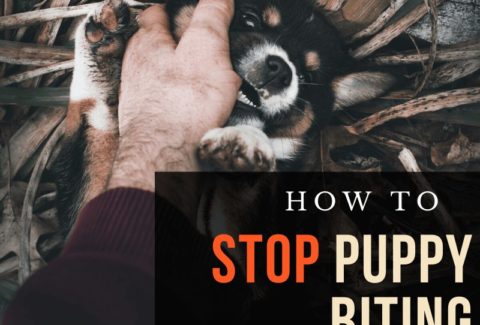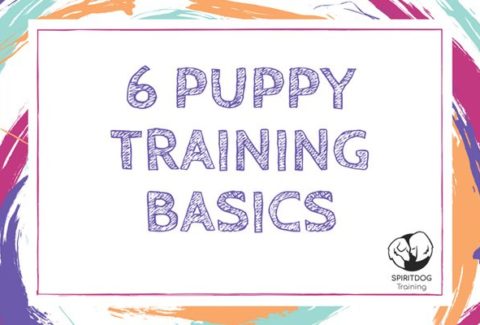Crate Training A Puppy: The Smart Way
February 15, 2021 2021-09-02 7:26Crate Training A Puppy: The Smart Way
Crate training a puppy a big topic for new dog owners. There are many benefits to crate training: Crates are a fantastic tool to keep your puppy contained and manage his sleeping schedules in the first month. They also provide him with a safe and comfortable resting spot that he might seek out his whole life!
Many questions come with crate training though:
How long, how often, how to start and when to transition? When should be the first time to crate a puppy? What should be inside the crate, and what amount if time does the training process take?
It can be tough to figure out what to do if your puppy cries in his crate, and how to move from crating to trusting your puppy to roam the house.
Table of Contents
Crate Training A Puppy – Is it Necessary?
Generally speaking, a puppy does not necessarily need to be crated.
However, a puppy needs to be safe. And this can be challenging because puppies have a lot of talent for not being safe.
Nobody can supervise their puppy 24 hours a day. Without supervision though, puppies are likely to get themselves into a ton of trouble, such as :
- Having potting accidents
- Chewing on furniture
- Ingesting dangerous objects (such as Q-tips)
- Snacking on toxic substances (such as indoor plants or chocolates)
- Pestering other animals of the family such as cats or adult dogs
Puppies have a surprising ability to do all kinds of things that are threatening to their own wellbeing.
If you cannot supervise your puppy, he needs to be restricted to a safe place. Especially highly energetic and destructive breeds such as Pitbulls benefit from crate training.
This safe place does not need to be a crate – it can also be an exercise pen or a very puppy-proof room.
However, using a crate is often the easiest solution as you can also move the crate around with you easily.
Even dogs that are usually kept loose in the house should be able to relax in a crate – so that they do not become stressed when they for example go on a long car ride or need to stay at the vet’s.
If you are planning to compete in dog sports or attend dog training seminars, being able to stay in a crate will be crucial for your dog. Dogs are crated there – often in so-called crating rooms – so that they can relax and wind down in between training or competition runs.
Having a dog be calm in a crate will come in very handy after his spay or neuter surgery as well.
(By the way – when you are setting that up make sure to check out Gallant – they are offering doggy stem cell banking. Check out Gallant to learn more!)
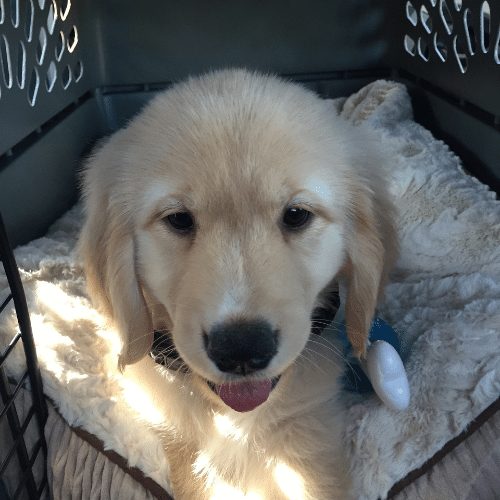
Crate Training A Puppy – Is It Cruel?
It it not inherently wrong to crate a dog for his or her own safety.
However – you should always watch out that the crate doesn’t become an easy solution for any behavioral problem. Young dogs need exercise, training and socialization.
Having a dog in a crate 16 hours per day is definitely not ideal and should be avoided. The same goes for using the crate as a punishment.
But – as long as you are smart and gentle about the training process, start with short periods and don’t leave the dog in the crate for a too long amount of time, there is nothing wrong at all about using a crate.
When should you start crate training a puppy?
Dogs are creatures of habit, and the habits are best learned early on. This means that the time to start crate training is as soon as you bring your new dog home.
He can already spend his first night at your house in his new crate. That way the crate will become just a regular part of normal life.
You risk anxiety and stress in your dog if you do not crate him until he is maybe 6 months old, and then attempt to put him into a crate for the first time.
Many puppies are actually crated at their breeders’ home for a short time every day. By continuing with this habit when your dog moves in with you, you will have a smooth transition.
Here is a training video of me working on crate training with my 8 week old Golden Retriever puppy:
5 Steps to Crate Training Success
Let’s look at which steps you should take to make sure your pup sees his crate as a place of relaxation. It is extremely important to build a positive connection early on so that your dog will accept and enjoy his crate throughout his life!
Crating a puppy at night
You can already have your puppy sleep in his crate the first night that he spends at your house. Some puppies may have already experienced a crate at their breeder or the rescue that you adopted them from.
But also if your puppy is new to the crate, he can sleep in there.
Pay attention to these key aspects:
- Only put your pup into the crate if he is really tired. Putting a wide-awake puppy into a crate will result in him fighting to get out!
- Make the crate extremely comfortable. Put a lot of blankets in there. Big crates can be made smaller by inserting a divider. You want the crate to be small and cozy. If you live in a hot climate, provide a water bowl for your puppy’s crate.
- Ideally you put the pup’s crate close to your own bed. This is the first night he spends away from his littermates and he might be scared! Hearing you breathing and moving will make him calmer.
A very young puppy might need to go to the bathroom during the night. He will likely let you know by stirring or whining and you should take him outside to do his business and then put him back into his crate to continue sleeping.
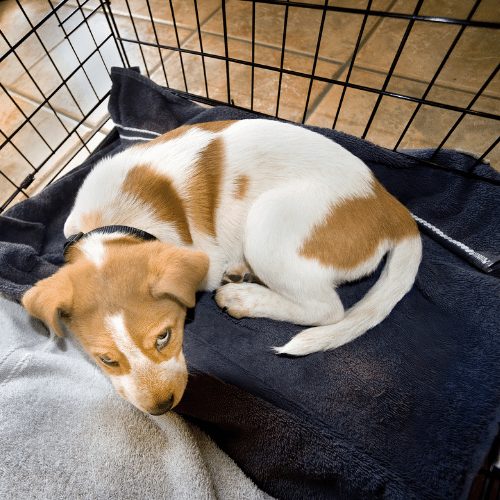
Crating a puppy during the day
During the day you would follow the same steps as during the night. Only put your puppy in his crate if he is tired. You should not put an awake and alert pup in his crate – he will only fight being in there.
A crate is never a way to “store” your puppy – it is a space to sleep and relax.
Focus on:
- Making the crate a positive place – feed your puppy’s meals in there or give him chew toys and bones in the crate.
- Giving the puppy space – other pets or kids should not approach the crate, knock on it or otherwise disturb the puppy.
- Associating the crate with sleep and calmness – put your puppy in there when he is worn out, such as after a long walk, a romp in the yard or a training session.
Should a puppy nap in his crate?
Yes – your puppy should absolutely nap in his crate. The more often you put him in there when he is sleepy, the easier he will associate the crate with sleep and calmness.
Young puppies take a lot of naps, so you will have plenty of opportunity to build this association.
Moving a sleeping puppy to his crate
If your puppy falls asleep outside of his crate, you can move him inside. Gently pick up the puppy and carry him to the crate. Very young puppies usually do not wake up while being “transferred” this way. Every single time your puppy sleeps in his crate peacefully will be another step to on the way to success.
In the car
Not every car can accommodate crates big enough for large or giant breeds. If it is at all possible to have your dog ride in a crate in the car however you should do so.
Not only is it yet another way to make a positive connection with the crate, but it will also keep your puppy from scrambling all over your seats and perhaps even climbing into your lap.
Just like with crate training during the day and night, the more often you can take your puppy on car rides, the better he will get with them.
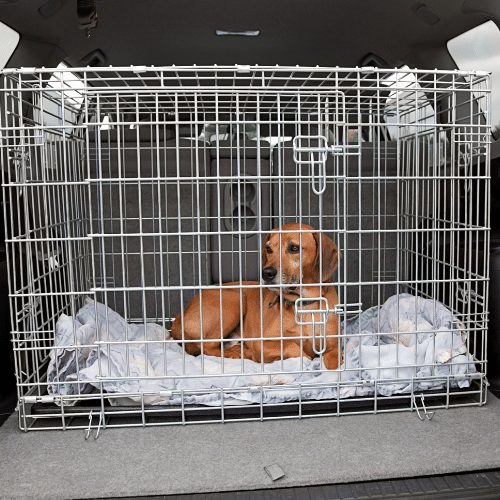
More crate training pointers
Here are some more training tips and tricks to make this process as smoothly as possible for you!
Place of relaxation
The more tired your puppy is when he is first crated, the easier it will be for him to understand that the crate is a place of rest and relaxation. Wound up and crazy puppies have a very hard time settling in the crate, and are likely to develop an apprehension against being crated. We want the exact opposite – we want our dog to seek out his crate to sleep and be calm.
Therefore, make sure that your puppy is ready for his nap before you crate him. If he is very rambunctious, you can also help him tune it down a notch by playing some housework games with him. Sniffing is a very calming activity for dogs. Scatter some food in your yard, or hide it inside under boxes or cups on the floor.
Your puppy will sniff intently to find the food, and while he does it, his focus will be turned to the ground, he will work concentrated and focused and calm himself down as he does so.
You can also give him a Kong filled with peanut butter or yoghurt that he can lick either before he goes into his crate, or while he is in it. Licking is another very relaxing activity for dogs that can bring down their energy level quickly and effectively!
Over time you can reverse this relation, and actually make him tired by putting him into the crate. Your dog will have made the connection between the crate and sleeping so many times that now the crate itself has become a symbol for going to sleep.
Feed meals in the crate
An easy and quick way to show your dog how fun the crate can be is to feed the meals in the crate. You can either put his filled food bowl into the crate, or even toss individual pieces inside. Once your dog is in the crate and eating, you can close the door for several minutes until he is done.
The idea behind this is that your dog will associate a positive emotion with anything that involves food. (You can also use this when e.g. trying to make vet visits more fun).
Don’t use the crate as a punishment
It is so tempting to put a misbehaving puppy in his crate. We have all been in a situation where that little obnoxious dog has shredded the 12th roll of toilet paper and we wanted to just lock him up. Using the crate as a time-out however will destroy the positive and calm associations that we built up in step 1. The crate is not a tool for disciplining your puppy!
If we put a wild, rambunctious puppy into his crate, he is likely to not be happy. We don’t want then puppy to associate the crate with being riled up and mad. We need him to know that the crate is a place of relaxation and sleep. A very wild puppy is not able to calm himself down sufficiently yet. We need to help him to relax.
If your puppy is full of trouble, try tethering him to you instead: put a leash on him and tie it on to your belt loops while you work on the computer, read a book or watch TV.
That way you can physically prevent your puppy from more destruction while also teaching him that getting too wound up is followed by some necessary down-time.
If it is not possible to tether the puppy, you can put him into a small, safe room: perhaps a bathroom or mud room. There he again cannot cause more trouble, and he will not view the time-out as linked to his crate.
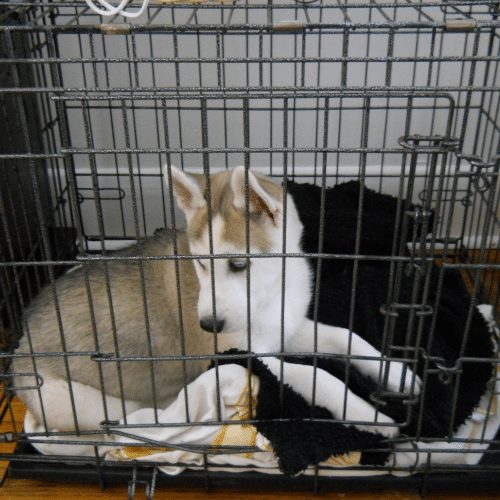
Make it a den
Dogs love safe, comfortable places. Puppies especially like to lay with their back against something. While yes – the crate is supposed to keep your dog from escaping – it should not look like a prison! Line the sides of your puppy’s crate with soft blankets or little pillows and It will remind him of the way he used to lay against his litter mates and mom!
Then drape another blanket over the crate to make it feel secure and comfortable and block out many bright light.
You can put his favorite toy in it (as long as he does not attempt to eat them) so your puppy has something to snuggle up against. Many puppies will love to sleep with a worn shirt of their owners, as it will give them the feeling of comfort and company.
The more your dog appreciates his crate, the easier it will be for him to relax and sleep in it.
While sleeping, dogs regularly wake up, stretch, turn around and go back to sleep. Try to get a crate that is large enough for your puppy to be able to turn around comfortably like that. While large crates can be expensive, you can check Craigslist for great deals on used crates. If in doubt, go with the larger size.
Keep others from bothering your puppy
Do you have more than one dog, other pets such as cats or children in your home?
Make sure that they know to leave your dog alone when he has his crate quiet time. It is important that other dogs don’t run by and try to make your puppy play through the bars or otherwise disrupt his sleeping. Your puppy will be very tempted to stop resting and try to join the play.
It needs to be clear to all members of the household that a dog in his crate is to be left alone.
Put the crate in a quiet part of the house to make this easier.
Dogs often start to really appreciate the crate as a place that they know they can go to if they need some alone time. You can leave the door open if your dog is not in it, and it may well be that over time he will seek out his crate to nap or just wind down if he is over-stimulated.
How Long Can An 8 Week Old Puppy Stay In His Crate?
Ideally, a dog should not be crated more than an hour for every month of age at a time. That means that a 2 month old puppy should be taken out after 2 hours, while a 4 month old dog can stay crated up to 4 hours during the day.
Dogs naturally are on a sleeping schedule that incorporates several small naps interspersed by periods of activity.
Use the crate for your puppy’s small naps during the day. A possible schedule could look like this:
- 6am Get up, potty, eat breakfast
- 7am Play, go for a little walk, do some training
- 8am-10am Nap in the crate
- 10am-12pm Go potty, play, hang around the house
- 12pm-2pm Nap in the crate
- 2pm-3pm Go potty, play, do some training
- 3pm-4pm Nap in the crate
- 4pm-7pm Go potty, play, go for a walk and get some socialization with people and other dogs, do some training
- 7pm Go to bed for the day
Your own dog’s daily schedule will vary based on his breed, age and activity level. Try to establish a napping schedule early on though – your puppy will be less grumpy, he will be happier and well-rested and his potty training will be easier, too! (Regulated sleeping and eating equal regulated digestion.)
Don’t leave your puppy in his crate for too long – when he is awake and ready for action he should come out and play. If you are gone during the day, consider a dog walker or neighbor dropping in to let your puppy out of his crate for some romping.
Your dog will only love his crate if you don’t overdo it – moderation is the key to a dog who enjoys his crate time!
Puppy Crying In The Crate – How To Respond
If you have followed the above advice, your puppy shouldn’t cry in his crate too often.
How to respond if he does though?
First, we need to remember that he just went through a big transition: From never being without his litter mates in his whole life, we now ask him to be able to sleep and settle alone. This can be hard for little puppies, and we should have patience with getting them settled and happy away from their original canine family.
If a puppy cries in his crate, I recommend to go and take him out to potty first (unless you just took him potty). Potty training is such an important part of training a puppy, and we don’t want to mess it up because we ignored a puppy’s signals who needed to go!
Once you checked if he perhaps needs to potty, go back to his crate with him, put him in and try to relax. I like to sit next to the crate with the puppy in it, you can also gently pet him. Try and make the situation as relaxing and calming as possible. The calmer and more patient you stay, the easier it will be for your puppy to go back to sleep – just like a human baby!
Again, make sure you are not leaving him in his crate for too long – a puppy who has just woken up from a long nap is ready to play and will of course cry if he is not able to. Don’t use the crate as a way to conveniently store the puppy – it should be a place to sleep, and when your puppy is done sleeping take him out.
Think of it like a human baby’s crib – of course a baby would cry if we left him in the crib and he is craving attention and interaction.
Your puppy’s first months are a formative period for the rest of his life. We want to teach our puppy that he can always rely on us. We will be the one that will always be there for him! Respond to his crying to show him that you are his friend and will support him when he needs you.
A dog who has experienced his owner coming when he is sad and lonely is much more likely to be a good listener and well-behaved, as he will value you and your guys’ relationship.
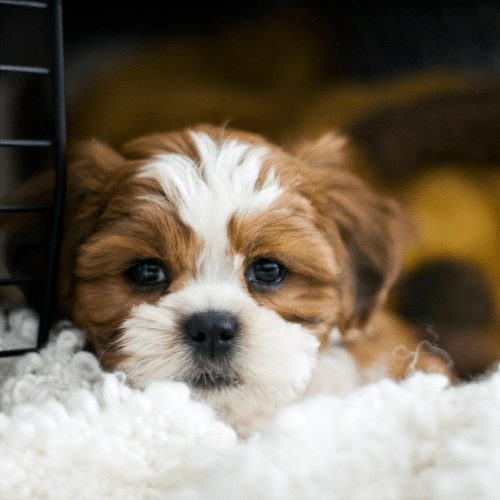
Transitioning your dog out of the crate
Eventually, it will be easiest if your dog can stay loose in the house during your absence. He will be able to stretch out his legs, look out of the window, play with his toys and not be as bored as he would be in his crate.
Prepare for the transition as early as possible by letting your puppy roam the house under your supervision. At night, you can tether him to you and let him fall asleep as you relax on the couch. If you are eating dinner, teach him to stay on a mat and not beg. It is tempting to use a crate as a management. Often though there are easy other solutions so that the crate can be reserved for your absence or for sleeping at night.
Time to say good-bye
After all that crate training, the day comes on which your dog will no longer need it and be ready top live a grown-up dog life without his crate! You can pass the crate on to friends or relatives with a new puppy or donate it.
Most dogs are ready to be left outside of a crate somewhere between 6 and 18 months.
Dogs that are very mouthy tend to take longer than breeds that are not prone to chewing or generally getting into trouble too much. Many Labradors will need a long time until they can be trusted to not try which furniture can be eaten, whereas especially toy breeds such as Dachshunds or Toy Poodles often need less supervision.
Your dog’s appropriate age for being left loose will depend on his breed, personality, activity level and your living situation. There is no formula to determine when he is ready. Listen to your intuition, owners spend much time with their dogs and know best when their dog can roam freely in the house.
When starting out, don’t make the period of no supervision too long, and have a neighbor or friend check in with your dog in the middle of the day. We don’t want him to get into trouble. Make sure you leave him alone only when he is tired, just like outlined above.
Then quietly leave without making a big deal about saying good-bye – your dog doesn’t understand it, and it will only wind him up if you give him many hugs and kisses. Leave him in the same calm way you left him in his crate, and he is most likely to just go to sleep until you return.
Open Door
Many dog owners keep the crate around even when their dog is no longer crated with the door closed. Dogs often remember the comfort of their crate (if training is done right) throughout their life and always enjoy to come back to it for a little nap.
If you have space, you can keep the crate around with the door open – your dog might just choose to settle in it here and there.
The Bottom Line
Crate training a puppy is no rocket science – follow the basic ideas of:
- Making the crate of place for sleeping
- Making the crate as comfortable as possible
- Keeping the crate environment quiet
- Ensuring the dog is left alone when resting in the crate
- Never using the crate as punishment
- Transitioning out of the crate in a smart way
- and you will have crate training success!
Have fun with your puppy, enjoy the puppy times and take many pictures, they grow up too fast.
Happy training!
Steffi Trott
Related Posts
How To Stop Puppy Biting – The Ultimate Guide
How To Discipline A Puppy
100 Ideas For Socializing Your Quarantine Puppy
6 Puppy Training Basics
Growing Up A Spiritdog: 4 Months
Poodle Pregnancy
Check out our effective and affordable online dog training courses!
-
Sale Product on sale
 Tackling Reactivity Bundle
Tackling Reactivity Bundle
MONEY BACK GUARANTEE$564.00$49.00 -
Sale Product on sale
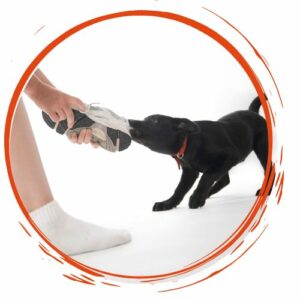 Perfect Obedience Bundle
Perfect Obedience Bundle
MONEY BACK GUARANTEE$349.00$49.00 -
Sale Product on sale
 Ultimate Puppy Bundle
Ultimate Puppy Bundle
MONEY BACK GUARANTEE$416.00$49.00 -
Sale Product on sale
 The Perfect Focus Bundle
The Perfect Focus Bundle
MONEY BACK GUARANTEE$445.00$169.00 -
Sale Product on sale
 Ultimate Masterclass Bundle
Ultimate Masterclass Bundle
MONEY BACK GUARANTEE$2,213.00$499.00

